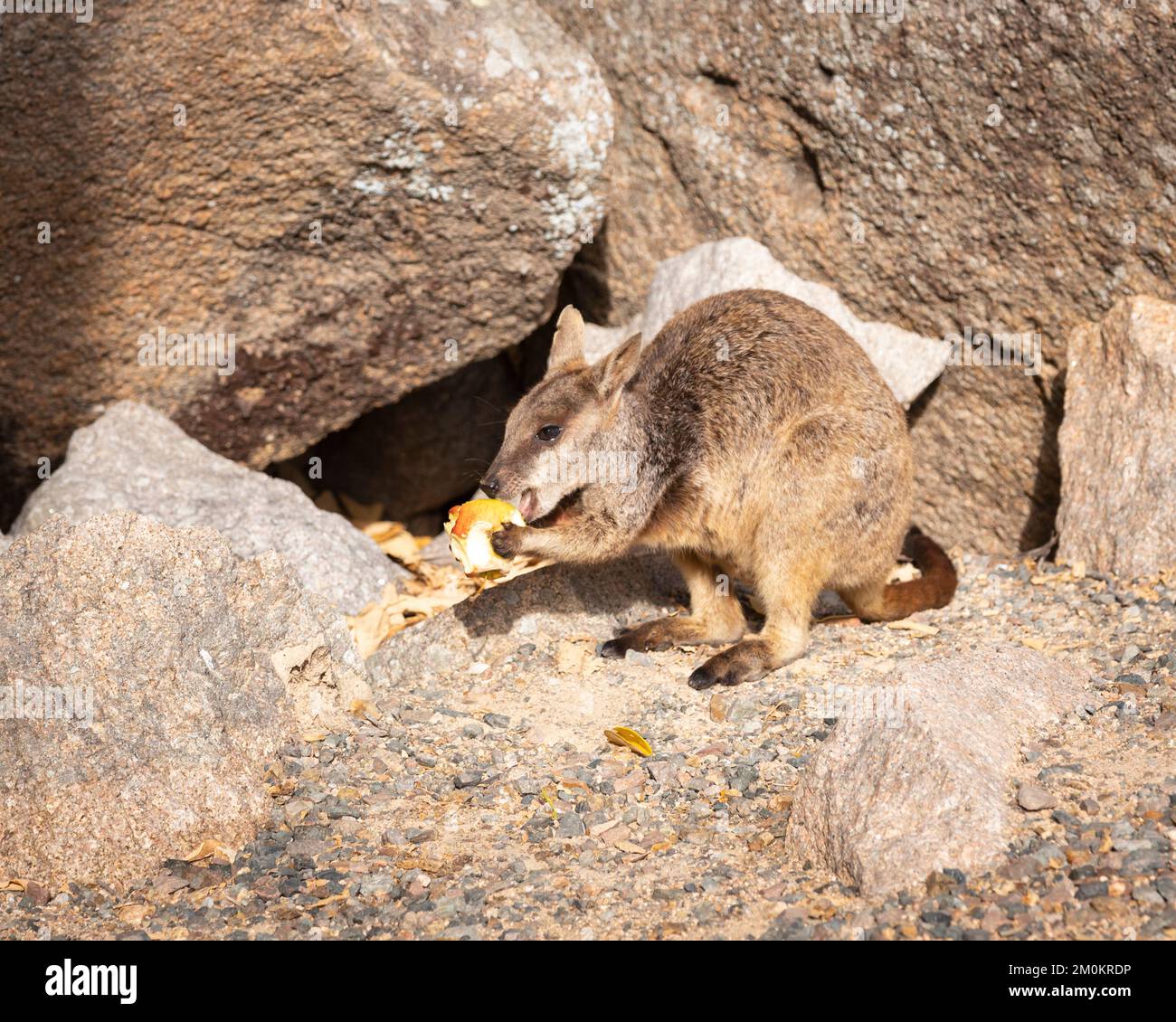The Rock Eating: A Deep Dive Into The Strange Yet Fascinating Phenomenon
Ever heard of the term "the rock eating"? No, it's not some new diet craze or a trendy fitness routine. It’s actually a real phenomenon that has scientists, geologists, and even casual observers scratching their heads. Imagine rocks—yes, actual rocks—being consumed by living organisms. Sounds like something outta a sci-fi movie, right? But believe it or not, this process is happening all around us, and it's more common than you might think.
Now, before you go thinking that Dwayne "The Rock" Johnson is secretly munching on boulders in his downtime, let’s clarify what we’re talking about here. The term "the rock eating" refers to a natural process where certain microorganisms and even animals consume or break down rocks for various reasons. It’s not just about breaking them apart; it’s about deriving nutrients, creating habitats, or even shaping entire ecosystems.
So, why should you care? Well, understanding "the rock eating" isn’t just about satisfying your curiosity. It’s about unraveling the mysteries of our planet, learning how life interacts with the environment, and even discovering potential applications in fields like agriculture, environmental science, and even space exploration. Stick around, because we’re about to dive deep into this rocky adventure!
- Cameron Brink Boyfriend Height The Inside Scoop Youve Been Waiting For
- How Old Is Fantasias Daughter A Deep Dive Into Her Life Family And Legacy
Let's jump into the nitty-gritty details of this fascinating topic. But first, here’s a quick table of contents to guide you through the rocky journey ahead:
- What is Rock Eating?
- Microbes to the Rescue: Who Eats Rocks?
- Animals Who Eat Rocks: Not Just Microbes
- Why Do Creatures Eat Rocks?
- Effects on the Environment
- Human Impact on Rock Eating
- Scientific Research and Discoveries
- Potential Applications of Rock Eating
- Fascinating Facts About Rock Eating
- Conclusion: What Does the Future Hold?
What is Rock Eating?
Alright, let’s get down to business. When we talk about "the rock eating," we’re referring to a process where certain organisms consume or break down rocks. This can happen in various ways, but the most common form involves microorganisms like bacteria and fungi that chemically break down minerals in rocks to extract nutrients. It’s like nature’s version of mining, except instead of big machines, you’ve got tiny critters doing all the heavy lifting.
But it’s not just about the microscopic world. Some animals, like birds and certain reptiles, also consume rocks—not to eat them per se, but to aid digestion or even build their homes. So, whether it’s a bacterium munching on iron or a bird swallowing pebbles to grind up its food, "the rock eating" is a fascinating intersection of biology and geology.
- Did Kris And Corey Break Up The Inside Scoop Youve Been Waiting For
- Unveiling The Truth Behind Jada Pinkett Smith And Cheating Allegations
How Does Rock Eating Work?
Here’s the science behind it. Microbes use chemical reactions to break down rocks, a process known as "chemical weathering." For example, some bacteria can produce acids that dissolve minerals like feldspar or quartz. Meanwhile, animals like gastropods and crocodiles use rocks as tools for digestion, swallowing them whole to help break down tough plant material.
It’s kind of like how we use blenders to make smoothies—except these creatures are built with their own natural blenders. And while it might sound bizarre, this process plays a crucial role in shaping ecosystems, influencing soil formation, and even affecting global climate patterns.
Microbes to the Rescue: Who Eats Rocks?
Let’s talk about the real stars of the show: microbes. These tiny organisms might be invisible to the naked eye, but they’re some of the most powerful rock munchers on the planet. Think about it—microbes have been around for billions of years, and they’ve had plenty of time to perfect their craft.
Types of Rock-Eating Microbes
- Lithotrophs: These are bacteria and archaea that derive energy from inorganic minerals found in rocks. They’re like nature’s ultimate recyclers, converting minerals into nutrients that other organisms can use.
- Fungi: Certain types of fungi, like mycorrhizal fungi, help break down rocks by secreting enzymes that dissolve minerals. They often work in tandem with plants, creating a symbiotic relationship that benefits both parties.
- Acidophiles: These are extremophiles that thrive in highly acidic environments, like volcanic hot springs or mine drainage sites. They produce acids that dissolve rocks, releasing valuable nutrients in the process.
So, the next time you’re hiking through a forest or exploring a cave, remember that there’s a whole world of tiny rock eaters hard at work beneath your feet. And without them, our planet wouldn’t be the lush, green paradise it is today.
Animals Who Eat Rocks: Not Just Microbes
While microbes might get all the glory, they’re not the only ones in on the action. Believe it or not, some animals also partake in the rock-eating craze, though their reasons might differ from those of their microscopic counterparts.
Examples of Rock-Eating Animals
- Birds: Many bird species, like ostriches and chickens, swallow small stones called "gizzard stones" to help grind up tough seeds and grains in their digestive systems. It’s like having a built-in food processor!
- Reptiles: Some reptiles, like crocodiles and turtles, also consume rocks to aid digestion. In fact, fossil evidence suggests that even ancient dinosaurs might have done the same.
- Fish: Certain species of fish, like the parrotfish, eat coral reefs as part of their diet. While they’re not eating solid rock, they’re still breaking down calcium carbonate structures, which technically counts as "rock eating."
It’s amazing how diverse the world of "the rock eating" really is. From birds to bacteria, it’s clear that this phenomenon plays a vital role in the survival of many species.
Why Do Creatures Eat Rocks?
Now that we know who’s eating rocks, let’s talk about why they do it. As it turns out, there are several reasons why creatures—both big and small—engage in this unusual behavior.
Reasons for Rock Eating
- Nutrient Acquisition: Microbes break down rocks to extract essential minerals like phosphorus, potassium, and magnesium. These nutrients are crucial for their survival and growth.
- Digestive Aid: Animals like birds and reptiles consume rocks to help break down tough plant material in their stomachs. It’s a natural way to improve digestion without relying on external tools.
- Habitat Creation: Some creatures, like parrotfish, break down coral reefs to create new habitats for themselves and other marine organisms.
- Environmental Influence: In some cases, rock eating might be a response to environmental stressors, like nutrient-poor soils or extreme weather conditions.
So, whether it’s for food, shelter, or survival, "the rock eating" serves a variety of purposes in the natural world. And as we’ll see in the next section, it also has a profound impact on the environment around us.
Effects on the Environment
When it comes to "the rock eating," the impact on the environment is both far-reaching and fascinating. This process doesn’t just affect the creatures doing the eating; it also shapes the landscapes around them, influencing everything from soil formation to climate regulation.
Positive Effects
- Soil Formation: Rock eating by microbes and other organisms helps break down rocks into smaller particles, creating nutrient-rich soil that supports plant growth.
- Carbon Sequestration: Certain types of rock eating can help remove carbon dioxide from the atmosphere, contributing to global climate regulation.
- Biodiversity: By creating new habitats and nutrient sources, rock eating supports a wide variety of plant and animal species.
Negative Effects
- Erosion: Excessive rock eating can lead to soil erosion, which can damage ecosystems and harm local wildlife.
- Mineral Depletion: If too many nutrients are extracted from rocks, it can lead to mineral depletion in certain areas, making it harder for plants and animals to thrive.
As you can see, the effects of "the rock eating" are complex and multifaceted. While it brings many benefits, it’s important to strike a balance to ensure the health of our planet.
Human Impact on Rock Eating
Humans have a complicated relationship with "the rock eating." On one hand, we rely on this process for things like agriculture and environmental management. On the other hand, our activities can disrupt natural rock-eating processes, leading to unintended consequences.
How Humans Influence Rock Eating
- Deforestation: Cutting down forests can reduce the number of microbes and fungi that break down rocks, leading to nutrient-poor soils.
- Mining: While mining can extract valuable minerals from rocks, it often disrupts natural rock-eating processes and harms local ecosystems.
- Pollution: Chemical pollutants can kill off rock-eating microbes and fungi, disrupting the balance of ecosystems.
However, humans are also working to harness the power of "the rock eating" for positive purposes. For example, scientists are exploring ways to use rock-eating microbes to improve soil health, reduce carbon emissions, and even terraform other planets.
Scientific Research and Discoveries
So, what are scientists doing to better understand "the rock eating"? As it turns out, there’s a lot of exciting research happening in this field right now. From studying ancient rock formations to experimenting with lab-grown microbes, researchers are uncovering new insights into this fascinating phenomenon every day.
Key Discoveries
- Microbial Diversity: Scientists have discovered an incredible diversity of rock-eating microbes, each with its own unique adaptations for surviving in harsh environments.
- Climate Regulation: Research has shown that rock eating plays a significant role in regulating the Earth’s climate by removing carbon dioxide from the atmosphere.
- Space Exploration: Some scientists are even exploring the possibility of using rock-eating microbes to terraform other planets, like Mars, making them more habitable for future human colonization.
With each new discovery, we’re getting closer to understanding the full scope of "the rock eating" and its implications for our planet—and beyond.
Potential Applications of Rock Eating
Speaking of implications, let’s talk about some of the potential applications of "the rock eating" in fields like agriculture, environmental science, and even space exploration.
Applications in Agriculture
- Soil Enrichment: By introducing rock-eating microbes into nutrient-poor soils, farmers can improve crop yields and reduce the need for chemical fertilizers.
- Pest Control: Certain rock-eating microbes can help control pests by outcompeting harmful organisms in the soil.
Applications in Environmental Science
- Carbon Sequestration: Rock eating could play a key role in reducing atmospheric carbon dioxide levels, helping to combat climate change.
- Reforestation: By enhancing soil health, rock-eating microbes can support reforestation efforts and restore degraded ecosystems.
Applications in Space Exploration
- Terraforming: Scientists are exploring the possibility of using rock-eating microbes to transform barren landscapes on other planets into habitable environments for humans.
The potential applications of "the rock eating" are vast and varied, offering exciting possibilities for the future of our planet—and beyond.



Detail Author:
- Name : Earline Williamson
- Username : delaney.smitham
- Email : veda27@friesen.org
- Birthdate : 1989-06-29
- Address : 72669 Jarret Street Suite 915 Port Scotty, MT 34613
- Phone : +12408160323
- Company : Bahringer Ltd
- Job : Sales Person
- Bio : Ut a dolores quam qui itaque totam. Adipisci eos quae libero et in praesentium. Laudantium repellat nisi qui et. Est perferendis perferendis perspiciatis et.
Socials
instagram:
- url : https://instagram.com/lindgren1981
- username : lindgren1981
- bio : Impedit qui id quibusdam et voluptatem ipsam quod. Consequatur quis est et voluptates veniam.
- followers : 4955
- following : 2409
twitter:
- url : https://twitter.com/brycen2382
- username : brycen2382
- bio : Quis molestiae dolorem numquam nihil. Quae voluptas rerum unde et. Laudantium voluptas cum sequi ut et error. Error similique sequi iusto.
- followers : 3714
- following : 564
linkedin:
- url : https://linkedin.com/in/brycen_lindgren
- username : brycen_lindgren
- bio : Itaque asperiores possimus voluptatem totam.
- followers : 4614
- following : 2381